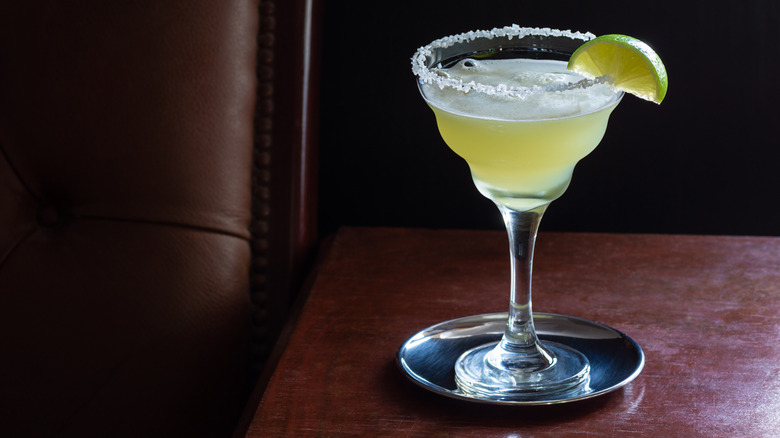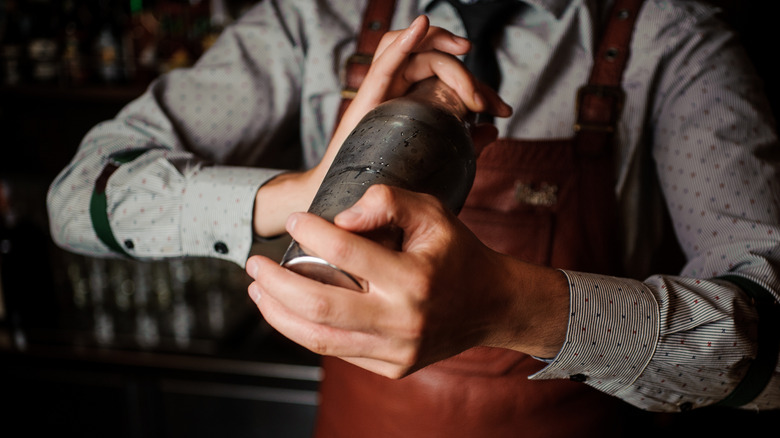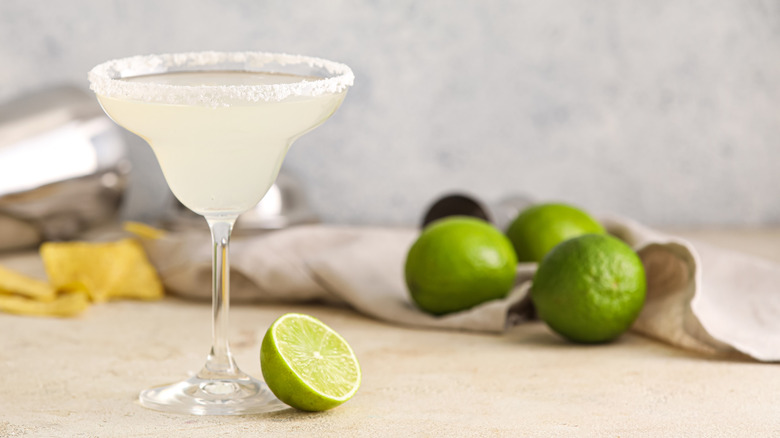Why You Should Follow Bobby Flay's Lead And Serve Margaritas Straight Up
I never order margaritas when I'm out. Don't get me wrong, I love them — they're my go-to drink when I'm at home. But, bars and restaurants never make them to my liking. To me, a margarita should be tart, punchy, and perfectly balanced — no sweeteners, no fancy garnishes, just fresh lime and decent tequila with an undercurrent of orange liqueur to mellow things out. But, saccharine syrups aren't my only gripe. Most establishments serve margaritas on the rocks, and to me, that's a sin.
Some drinks are meant to be served on the rocks. Margaritas are not. They're watery enough straight out of the shaker, so all that melting ice just hides the taste of the tequila, lime, and orange liqueur. That's fine — even preferable — for drinks made from bottom-shelf margarita mix. But, over the past few decades, mezcal has gone mainstream. Nowadays, high-end tequilas are a liquor store staple. It's time for margaritas to catch up.
Fortunately, I have a famous figure on my side. Celebrity chef and restaurateur Bobby Flay is a fan, too. Flay recommended the straight-up technique in an Instagram reel promoting friend and Food Network star Michael Voltaggio's new tequila, Marcado 28. "Usually I make a margarita on the rocks," Flay explained to the camera. "But I'm gonna make one straight up. Let's make it a thing." I know that serving margaritas straight up sounds like sacrilege to some, but I have numbers on my side.
Why should you serve margaritas straight up?
Before serving a cocktail straight up, bartenders use either a mixing glass or cocktail shaker to combine the ingredients and chill the drink. But, mixing serves another purpose: It adds water. That added water, called dilution, is key to a good cocktail. Typically, it makes up 15 to 30% of a drink.
You might think that sounds like a scam, but bartenders aren't trying to steal your money with watered-down drinks. A margarita with three ounces of booze is still a margarita with three ounces of booze, with or without extra water. Water mellows the drink and brings out subtle notes. Dilution is the difference between a refined, refreshing cocktail and a booze-heavy punch to the face.
While dilution doesn't impact the alcohol content, it does impact the flavor. Add too much water, and you'll get a bland, watery disappointment of a drink. Traditionally, margaritas are shaken — which adds around 30% dilution. That's not a problem if you serve the drink straight up, but add ice, and you're pushing 40% — way too watery!
Many bars and restaurants batch margaritas and have readymade vats on hand. But, batched margaritas don't give you that aerated, icy texture that comes from a shaken drink. It's just another thing that gets lost in restaurant margaritas.
How does Bobby Flay make margaritas?
Nixing the ice isn't the only thing that Bobby Flay does right. The celebrated chef follows the classic 2:1:1 ratio with two ounces of tequila, one ounce of orange liqueur, and one ounce of fresh-squeezed lime juice. For the booze, he paired Marcado 28's reposado tequila with Cointreau.
"I'm gonna use reposado, which means "rested" ... so it has a little bit of amber color to it," Flay explained. After shaking the drink, he strained it into a coupe glass and added a lime garnish. Personally, it sounds perfect — and many commenters agreed. "That's exactly how I make mine," one person wrote. Another added, "Started ordering margaritas like this years ago and bartenders would look in shock."
Not everyone was a fan, though. "Wait.....not even a tiny hint of sweetness from agave or simple?" read one comment. Others acknowledged that it "would be too tart for some," while a few commenters bemoaned the lack of a salt rim.
Like Flay, I view the salt rim as optional, but it serves a purpose. Salt helps level out the lime by tricking your taste buds, so try it if you think the unsweetened drink is too sour. There's a time and place for sweetener, too. Some limes are sweeter than others, so sweeten accordingly. I can't speak for Flay, but I won't judge — just as long as you don't add ice.


